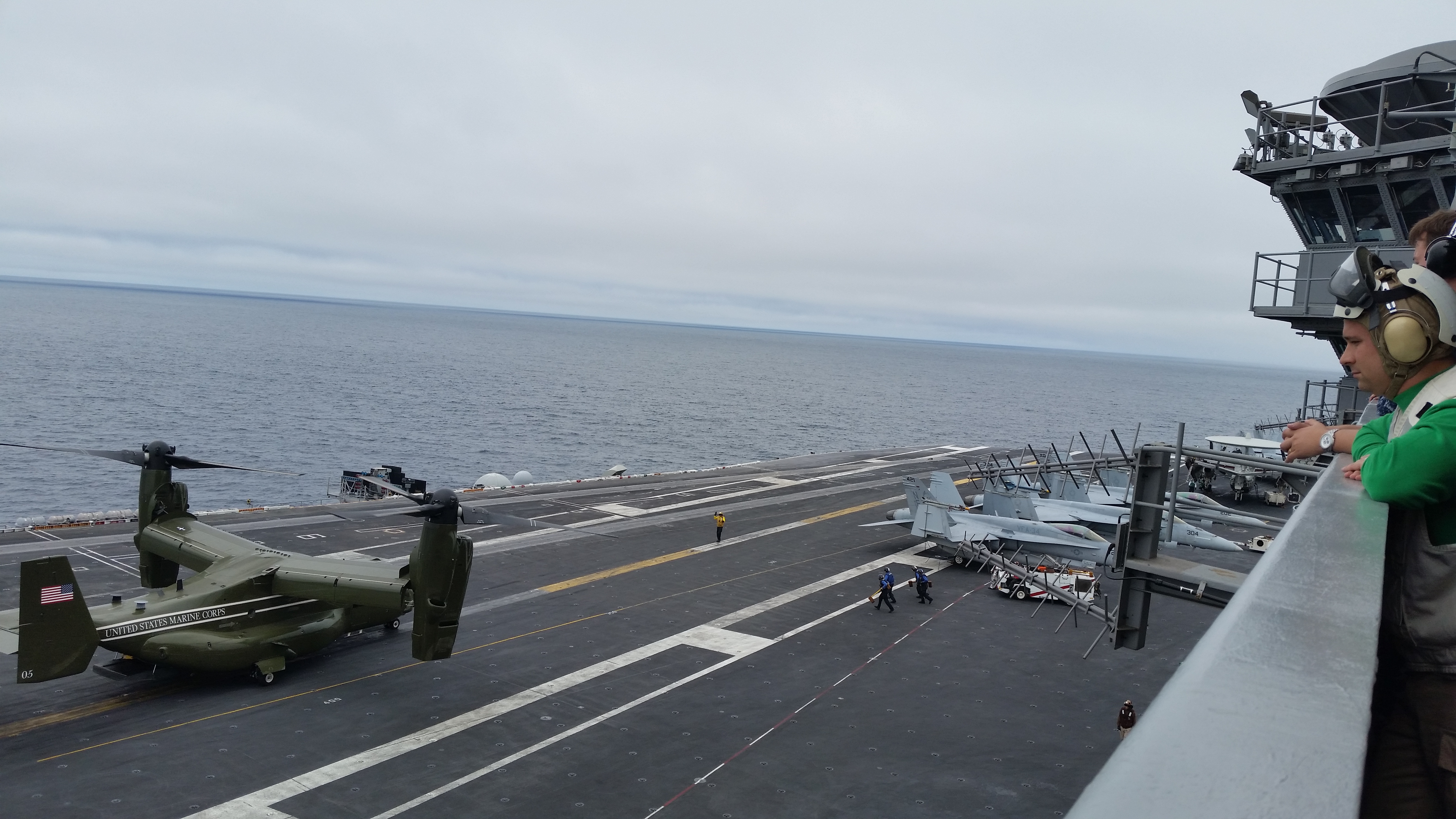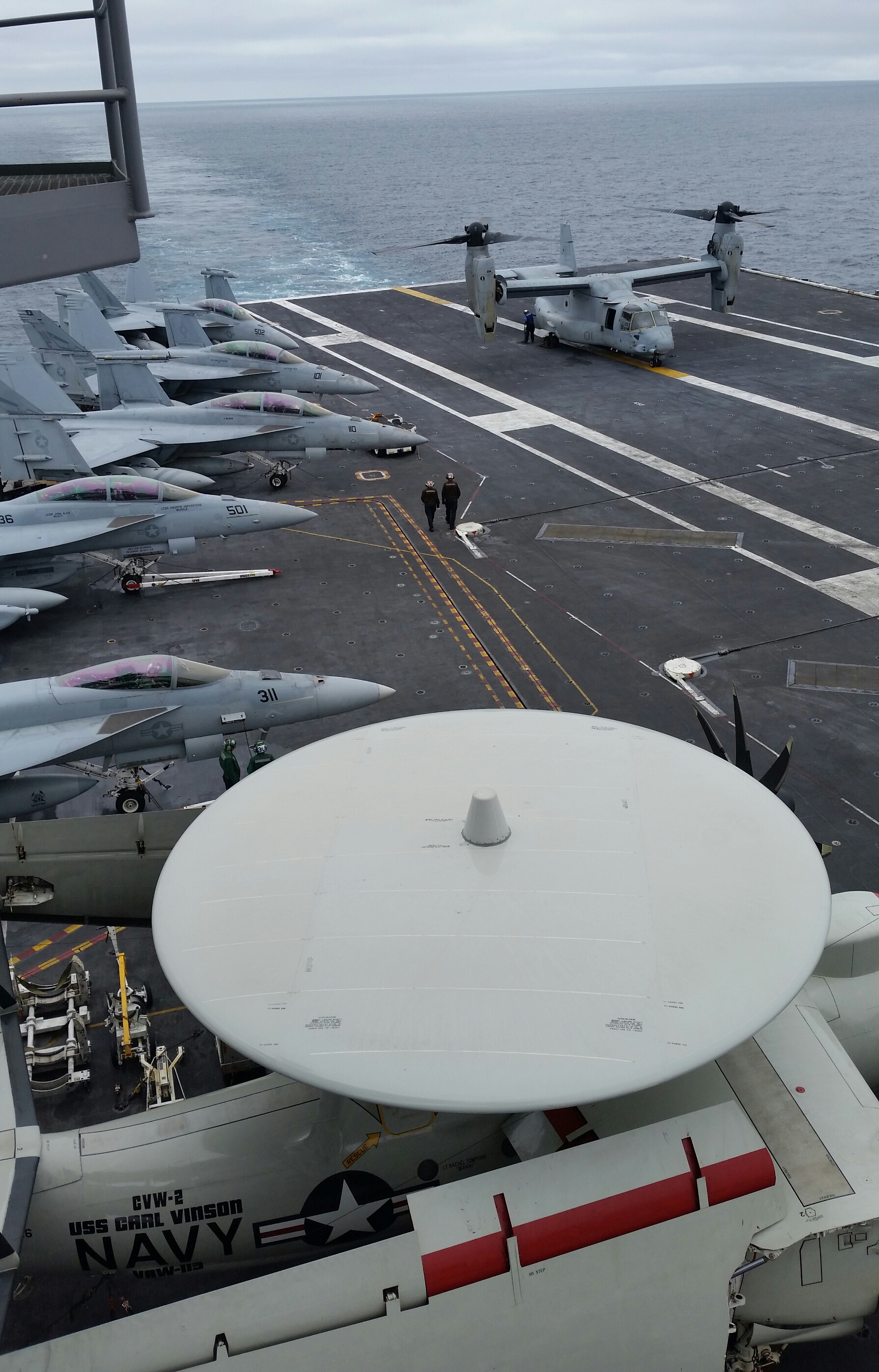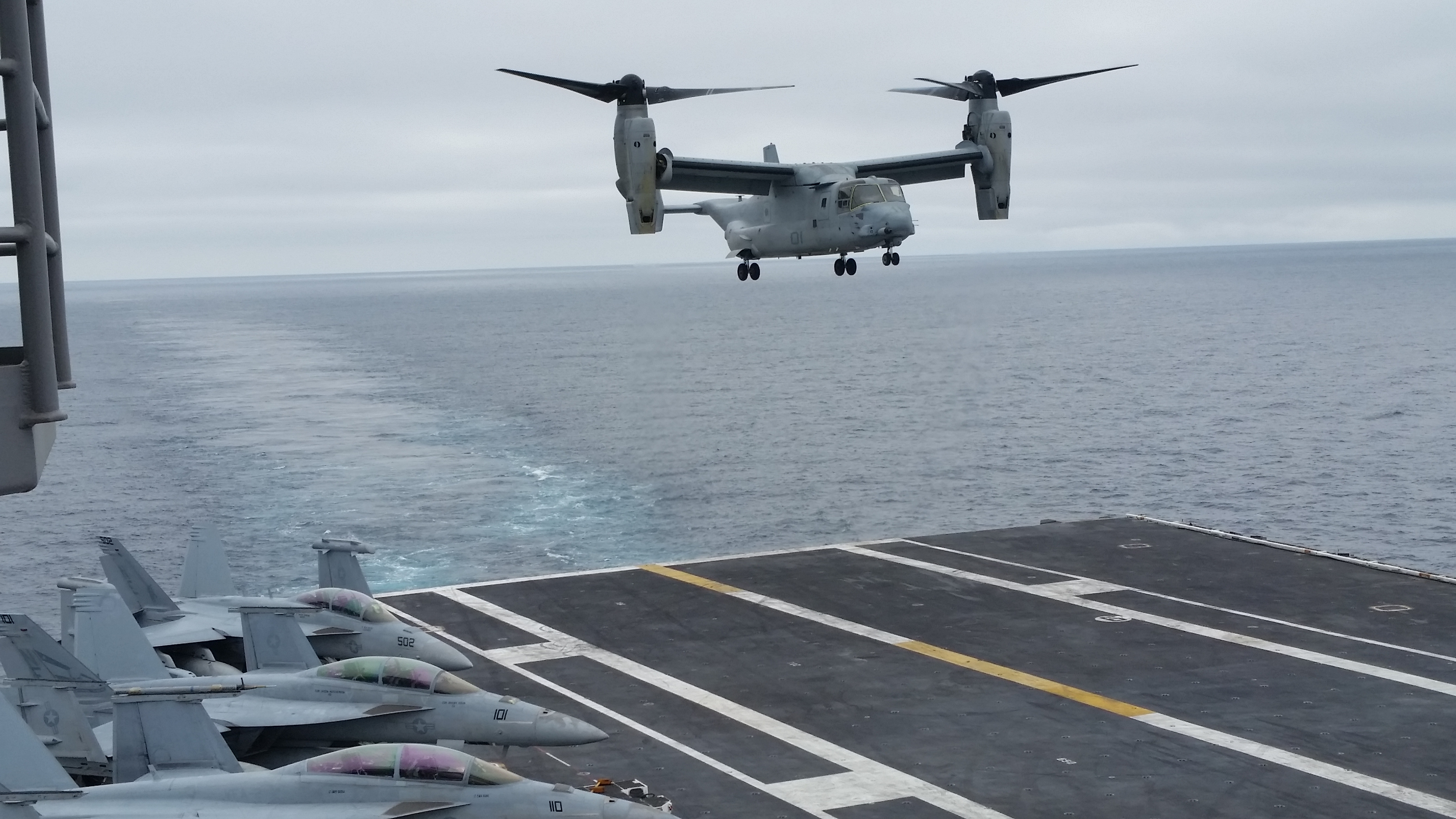
ABOARD AIRCRAFT CARRIER USS CARL VINSON — Ten days into a two-week fleet battle experiment on this aircraft carrier off the California coast, the Navy is getting a good look at how the V-22 Osprey tiltrotor can fit into flight and deck operations of its carrier fleet. So far, the outlook is promising.
The Osprey is slated to replace the C-2A Greyhound as the carrier onboard delivery aircraft, doing the COD logistics mission of hauling cargo, mail and passengers between aircraft carriers and beach detachments ashore. After that decision in January 2015, the Navy approved an engineering change for a naval variant of the V-22, and this year is working with the Marine Corps as it supports Osprey operations this summer for the fleet battle experiment (FBE).
The Marine Corps is flying four MV-22B aircraft aboard USS Carl Vinson since the experiment began July 22. Three of the Ospreys belong to Marine Helicopter Squadron 1 from Quantico, Va., and the fourth belongs to Marine Operational Test and Evaluation Squadron 1 (VMX-1) from Yuma Marine Corps Air Station, Ariz.]
This initial “proof of concept” will begin to show how to employ the Osprey, which blends rotary and fixed-wing flight, and see how it affects cycles of launch and recovery operations and overall deck handling on a carrier, officials said. “This is an opportunity to go out and see how this is going to do,” said Vice Adm. Mike Shoemaker, Naval Air Forces commander, speaking with a group of reporters Tuesday before boarding an HMX-1 Osprey for the flight to the Carl Vinson conducting training in the offshore ranges.
So far, it seems, initial tests don’t reveal any glaring problems that time and experience couldn’t smooth out. “I think it’s going very well,” Shoemaker said. Some worries about downwash from the Osprey’s beefy rotors haven’t materialized, perhaps in part from more handling and simple adjustments with pilots moving the nacelles to ease the heat and deflect the exhaust on the flight deck surface. He said the downwash is “comparable” to that of the MH-53 helicopter.
One good thing: Landing and launching an Osprey, which can land and take off vertically like a helicopter, lightens the deck crew load since it requires no wire trap and isn’t catapulted off the deck. Plus, it isn’t limited to just flying during fixed-wing operations. Only five personnel are needed on deck, several Carl Vinson officers told a group of reporters Tuesday, far fewer than the 30 to 50 hands usually on position when the Greyhound is operating on deck.
A concern: Turnaround time to unload or load the Osprey might take longer than the Greyhound, potentially cutting into the deck cycling window between flight operations. That’s because deck crews would offload and load the Osprey while it’s still in the landing and launching spot — spots 6 at the “waist” or 9 by the fantail — rather than outside the landing area where the Greyhound and cargo go when being moved or pre-staged for delivery. Both spots will require different approaches to safely move cargo and passengers.

“It becomes how fast can you offload the Ospreys to get fuel and put the people back on so it can be off the flight deck, and then I’ll deal with the rest,” said Lt. Cmdr. Reynaldo Stanley, the flight deck handler. “The impact is on deck time.” In flight deck control, Stanley briefly described deck operations using a “ouija” board, with silhouette cutouts of each aircraft scaled to the flight deck to help track and position aircraft. He had no cutouts of the Osprey but used those of the now-defunct H-46 Sea Knight tandem-rotor helicopter.
“The C-2 is a big plane… It takes a lot of real estate in the parking area,” Stanley said. “The Osprey takes up a lot of real estate in the landing area.” The V-22 and C-2 have similar-sized footprints (one’s width is roughly the other’s wingspan) when operational so they take up similar space. The V-22 lands but can’t taxi and park with its wings folded like the Greyhound since its engines are shut down when it’s folded up. “When the C-2 lands, the intent is to park,” and then offload, reload and refuel before taxiing for another flight, he said, but most Osprey flights will entail landing and offload followed by any reloading and subsequent takeoff.
Vinson’s flight deck crew got their first familiarization with the Osprey in June when Marines brought several Ospreys for a sea trial of sorts. So far, “I think it’s gone pretty smoothly. But nothing’s happened, that is the key,” Stanley said.
“The most difficult thing we have is the aircraft would be on deck a little bit longer than was expected, which would eat up into the launching of the aircraft,” he said. “The longer it takes to take off, then the longer it takes for us to actually set up for cats (and fixed-wing flight ops) if we’re stuck up here and can’t launch” if the Osprey is on spot 6.
Navy officials cautioned that the experiment is starting to sort out and determine the Osprey’s operations and deck procedures in doing the COD mission. As of Tuesday morning, the carrier had handled 23 flights that moved 598 people and 33,000 pounds of cargo, said Cmdr. Clarke “Cosmo” Cramer, the fleet introduction team leader. The Center for Naval Analyses is collecting data from flight and deck operations during the experiment, including the timing between flight ops cycles andimpacts on moving cargo and passengers.
Cmdr. Lucas Kadar, Vinson’s Air Boss, said the Osprey “brings us flexibility and options. It’s easier from a flight deck point of view to operate with the MV-22… We don’t have to go into fixed-wing flight ops.” It provides more options, Kadar said, and has the “best of both worlds” since it can conduct flight missions faster than helicopters but also land or launch regardless of the flight deck status and also between launches and recoveries.
A short utility assessment conducted aboard USS Harry S. Truman in 2013 gave the service an initial look at whether the Osprey might fulfill the COD mission when the C-2A is retired. “Our C-2 community is like the masters of global logistics,” Shoemaker said, with detachments supporting ships and ashore units.
“What we’re trying to do is help inform the future,” Shoemaker added. That includes determining “how will we employ this airplane, maybe differently or similar to the C-2.” The Navy hasn’t yet tested flying the Osprey to smaller ships like destroyers or cruisers, although the V-22 could hover over ships’ flight decks. “We are just kind of scratching the surface in how we’ll use this platform,” he said.

Another difference is that unlike the C-2A, the Navy would use the Osprey to carry cargo at night. The V-22B carries a bit less internal cargo than the Greyhound, but it can lift more and haul cargo by sling load. The Osprey has three fewer seats available, 23 compared to 26 in the Greyhound. The C-2A can fly higher, above bad weather, with its pressurized cockpit that the Osprey lacks.
“I think it’s still a very good fit for the mission,” Shoemaker said of the Osprey.
The Navy is looking at how to make cargo handling more efficient, officials said, with specialized metal bins, the Joint Modular Intermodal Container (JMIC), that can be rolled onto the Osprey and also corrugated cardboard boxes and palletized cargo that can shorten the turnaround time. The C-2A has a cage that contains loose items, but containers on the V-22 will allow pre-staging of cargo rather than sailors packing it in “hand over hand, stacking it in where they can,” said Lt. Cmdr. Matthew Miller[cqgf], Vinson’s principal assistant for logistics.
The testing, done closely with VMX-1, is led by a fleet introduction team from Point Mugu, Calif.-based Airborne Command, Control and Logistics Wing, which manages the C-2 and E-2 fleet. Between October and February, the first group of 77 C-2 pilots, aircrewmen and maintainers will get training with the V-22B and will “start flying the airplane,” said Capt. Val Overstreet, the wing commodore and veteran E-2 pilot. “We are really excited about that.” They will provide the first training cadre and become instructors for follow-on crews at New River Marine Corps Air Station, N.C. They will be followed by helicopter pilots who plan to transition to the V-22, she said.
Shoemaker said the Navy expects to reach initial operational capability (IOC) in fiscal 2021, with the first detachment deployed during 2022. “We’ll do it very similar to how we are set up now with the C-2 community,” he said, with east and west coast-based squadrons providing V-22 dets to carriers. He said he thinks the Navy might, at some point, stand up its own V-22 training squadron.
The Navy’s version of the Marine Corps’ newest rotary-wing aircraft would be designated CMV-22. It would mirror the aircraft that the Marines fly but will include extended range fuel tanks, high frequency radio and a public-address system. Unlike the COD it’s replacing, the Navy’s Osprey variant potentially could operate off other gray hulls.





